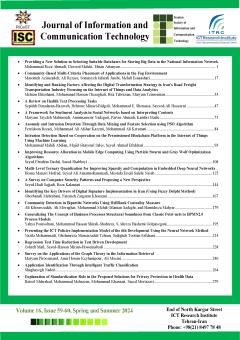A Framework for Sentiment Analysis in Social Networks based on Interpreting Contents
Subject Areas : ICT
Maryam Tayfeh-Mahmoudi
1
,
َAmirmansour Yadegari
2
,
Parvin Ahmadi
3
![]() ,
kambiz badie
4
,
kambiz badie
4
1 -
2 - ICT Research Institute
3 - IRAN Telecommunication Research Center (ITRC)
4 -
Keywords: Interpreting content, sentiment analysis, social network, classes of message, if-then type rules,
Abstract :
Interpreting contents with the aim of analyzing the sentiment of their narrators in social networks, holds a high significance due to the role of a content in disseminating information to the corresponding human groups. In this paper, we propose a framework for analyzing sentiment on complex contents in a social network according to which a set of if-then type rules defined at high abstraction level, would be able to classify the messages behind these contents. According to this framework, items such as prosodic, context and key propositions are considered in the condition part of a rule and possible classes of message are taken into account in a rule’s action part. It is to be noted that the rules proposed for interpreting a content do not depend on the considered language due to the very inherent property of the items which are considered in interpretation. Results of experiments on a wide range of different contents in a social network support the fact that the proposed framework is sufficiently capable of analyzing the sentiments of contents’ narrators.
[1] رجبی، زينب، محمدرضا ولوی و مریم حورعلی، "مروری بر روش¬های تحلیل احساس در متون فارسی"، فصلنامه پردازش علائم و دادهها، شمارة 2 پیاپی 52، 1401.
[2] عسگریان، احسان، محسن کاهانی و شهلا شریفی، "حس نگار: شبکه واژگان حسی فارسی"، فصلنامه پردازش علائم و دادهها، شمارة 1 پیاپی 35، 1401.
[3] علیمردانی، سعیده، عبداله آقایی، "ارائة روش نظارتی برای نظرکاوی در زبان فارسی با استفاده از لغتنامه و الگوریتم "SVM، نشریه مدیریت فناوری اطلاعات دانشکده مدیریت دانشگاه تهران، دوره 7 شماره 2، 1394.
[4] E. Asgarian, M. Kahani and S. Sharifi, "The impact of sentiment features on the sentiment polarity classification in Persian reviews", Cognitive Computation, vol. 10, no.1, pp. 117- 135, 2018.
[5] R. Dehkharghani, "SentiFars: A Persian Polarity Lexicon for Sentiment Analysis", ACM Transactions on Asian and Low Resource Language Information Processing, vol. 19, no. 2, pp. 21, 2019.
[6] مرادی، مهدی، پروین خسرویزاده، و بهرام وزیرنژاد، "ساخت پیکرههای نشانهگذاریشده با رویکرد وب به عنوان پیکره"، دومین هماندیشی زبانشناسی رایانشی، تهران، 1391.
[7] نجفزاده، محسن.، سعید راحتی قوچانی و رضا قائمی، "یک چارچوب نیمه نظارتی مبتنی بر لغت نامه وفقی خودساخت جهت تحلیل نظرات فارسی"، فصلنامه پردازش علائم و دادهها، جلد ۱۵ شماره ۲، صفحه 89-102، 1397.
[8] E. Cambria, "An introduction to concept-level sentiment analysis", in Proceedings of Mexican International Conference on Artificial Intelligence, Springer, Berlin, Heidelberg, November 2013, pp. 478-483.
[9] E. Cambria, B. Schuller, Y. Xia, and C. Havasi, "New avenues in opinion mining and sentiment analysis", IEEE Intelligent systems, vol. 28, no.2, pp.15-21. 2013.
[10] N. Ofek, S. Poria, L. Rokach, E. Cambria, A. Hussain, and A. Shabtai, "Unsupervised commonsense knowledge enrichment for domain-specific sentiment analysis", Cognitive Computation, vol. 8, no. 3, pp. 467-477, 2016.
[11] Z. Rajabi, M. Valavi, and M. Hourali, "A model for enriching sentiment lexicon based on semantic knowledge base", in Proceedings of 10th Iranian C4I Conference, Iran, 2017.
[12] شمس، م.، براآنی، ا.، هاشمی، م.، " بهبود استخراج جنبه های متن با استفاده از دانش دامنه و گراف کلمات"، دو فصلنامه علمی-پژوهشی فناوری اطلاعات و ارتباطات، شماره 55، دوره 15، بهار 1402.
[13] J. D. Kumar, S. Qamar, S. R. Sangwan, W. Ding, and A. J. Kulkarni, "Ontology-based Natural Language Processing for Sentimental Knowledge Analysis Using Deep Learning Architectures", ACM Transactions on Asian and Low-Resource Language Information Processing 23, no. 1, pp.1-17, 2024.
[14] A. Sureka and D. Correa, "Generating domain-specific ontology from common-sense semantic network for target specific sentiment analysis", in Proceedings of the 5th International Conference of the Global WordNet Association. Mumbai, India, 2010.
[15] E. Kontopoulos, C. Berberidis, T. Dergiades, and N. Bassiliades, "Ontology-based sentiment analysis of twitter posts", Expert systems with applications, vol. 40, no.10, pp. 4065-4074, 2013.
[16] B. Agarwal, N. Mittal, P. Bansal, and S. Garg, "Sentiment analysis using common-sense and context information", Computational Intelligence and Neuroscience, vol. 2015.
[17] B. Agarwal, and N. Mittal, "Sentiment analysis using conceptnet ontology and context information", Prominent Feature Extraction for Sentiment Analysis, Springer, Cham, 2016, pp. 63-75.
[18] F. Amiri, S. Scerri, and M. Khodashahi, "Lexicon-based sentiment analysis for Persian text", In Proceedings of the International Conference on Recent Advances in Natural Language Processing, 2015, September, pp. 9-16.
[19] A. Bagheri, and M. Saraee, "Persian sentiment analyzer: A framework based on a novel feature selection method", International Journal of Artificial Intelligence, vol. 12, no.2, pp. 115-129, 2014.
[20] حاجی عبدالله، شقایق، و میرزارضایی، میترا، "بهبود شناسایی قطبش در تحلیل احساسات به کمک طعنه کاوی و الگوریتمهای یادگیری ماشین در توییت های فارسی"، دو فصلنامه علمی-پژوهشی فناوری اطلاعات و ارتباطات، شماره 53، دوره 14، پائیز-زمستان 1401.
[21] E. Vaziripour, C. Giraud-Carrier, and D. Zappala,"Analyzing the political sentiment of tweets in Farsi", in Proceedings of the 10th International AAAI Conference on Web and Social Media, March 2016.
[22] S. S. Sadidpour, H. Shirazi, N. M. Sharef, B. Minaei-Bidgoli, and M. E. Sanjaghi, "Context-sensitive opinion mining using polarity patterns", International Journal of Advanced Computer Science and Applications, vol. 7, no. 9, 2016.
[23] ابومحمد حرّانی، "تُحَفُ العقول عَن آلِ الرّسول (ص)"، ترجمه صادق حسن¬زاده، انتشارات آل علی (ع)، چاپ یازدهم، 1388.
[24] سید روحالله موسوی خمینی، "شرح حدیث جنود عقل و جهل"، مؤسسه تنظیم و نشر آثار امام خمینی، چاپ پنجم، 1380.
[25] Hilgard, E.R. (1980). The trilogy of mind: Cognition, affection, and conation. The Journal of the History of Behavioral Sciences, vol.16, 107-117.
[26] Kolbe, K. (1990). The Conative Connection: Acting on Instinct, Reading, MA: Addison-Wesley.
[27] Waisel, L. (2013). On KOLBE Capabilities and Research. Report: Kolbe Corp.


